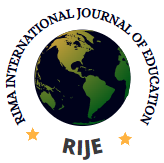Investigating Attitude of Hearing-impairment Students towards Learning Multiplication among Lower Basic Students in A. A. Raji Special School Sokoto, Sokoto State, Nigeria
1B. U. Binji
Faculty of Education, Department of Science Education, Sokoto State University
2Muhammad Nasiru Hassan
Faculty of Education, Department of Science Education, Sokoto State University
3Bello Shehu Aliyu
Faculty of Education, Department of Science Education, Sokoto State University
4Usman Galadima
Faculty of Education, Department of Science Education, Sokoto State University
Abstract
Multiplication concept is one of the pre-requisite skills needed for better understanding and development of mathematics skills. Students' understanding, development of basic mathematical skills, and performance are affected by some factors, that include, attitude, instructional process, and materials used among others. The present research investigates the hearing-impaired students’ attitude toward using the Chinese stick method in learning multiplication in Sokoto state Nigeria. One group of pre-test and post-test research design was employed, a sample of 344 was purposively selected. An attitude questionnaire for the use of the Chinese stick method of Multiplication was adapted and used for data collection after being subjected for the expert validation and also a reliability index of 0.87 using Cronbach alpha was obtained. The results obtained indicate that students have a positive attitude on the overall score when they are exposed to the Chinese stick method. Mann-Whitney U-test was used to analyze the two hypotheses. The results indicate a significant difference on students’ attitude scores before and after using the Chinese stick method in learning multiplication and that no significant gender difference was found between male and female students after using the method. Thus, this indicated that the use of the stick method can enhance the attitude of hearing-impairment. Based on this the stick method can be used as a tool for improving students' attitudes and performance in learning multiplication concepts.
Keywords
Hearing-impairment, Attitude, Chinese stick method
Reference
Aiken, L. R. (1976). Update on Attitudes and Other Affective Variables in Learning Mathematics. Review of Educational Research, 46 (2): 293–311. https://doi.org/10.3102/00346543046002293
Aliyu, B. S. (2019). Impact of Golosia and Japanese Multiplication Techniques on Attitude and Performance Among Primary Five Pupils in Tureta, Sokoto State Nigeria. Unpublish Masters Thesis Department of Science Education Ahmadu Bello University Zaria, Nigeria.
Atebe, H. U. & Schäfer, M. (2011). The Nature of Geometry Instruction and Observed Learning-Outcomes Opportunities in Nigerian and South African High Schools. African Journal of Research in Mathematics, Science and Technology Education, 15 (2): 191–204. https://doi.org/10.1080/10288457.2011.10740712
Delamater, J. D. & Myers, D. J. (2010). Social Psychology (E. Mitchell (ed.); Seventh). Cengage Learning Products are Represented in Canada by Nelson Education, Ltd.
Hashim, M. H. . (2016). Design and Development of E-Learning Environment for Deaf Students in Learning Nuclear Energy (Issue September). Universiti Teknology Malaysia.
Hassan, M. N. & Binji, B. U. (2016). Effect of Gelosia Method of Multiplication on Primary Five Pupils’ Mathematics Performance in Sokoto South Local Government, Nigeria. International Journal of Contemporary Education and Management, 11 (2): 35–44.
Mazana, M. Y., Montero, C. S. & Casmir, R. O. (2019). Investigating Students ’ Attitude towards Learning Mathematics. International Electronic Journal of Mathematics Education, 14 (1): 207–231. https://doi.org/doi.org/10.29333/iejme/3997
Mill, C. R. (1960). Attitudes Affect Pupils ’ Learning. In Educational Leadership (pp. 212–216). http://www.ascd.org/ASCD/pdf/journals/ed_lead/el_196001_mill.pdf
Ngussa, B. M. & Mbuti, E. E. (2017). The Influence of Humour on Learners’ Attitude and Mathematics Achievement: A Case of Secondary Schools in Arusha City, Tanzania. IJRDO-Journal of Educational Research, 2 (3): 170–181. https://ijrdo.org/index.php/er/article/view/165/139
Ogan, G. C. & George, N. R. (2015). Investigating Difficult Concepts in Senior Secondary School Mathematics Curriculum as Perceived by Students. International Journal of Academic Research and Reflection, 3 (6): 67–74. http://www.idpublications.org/wp-content/uploads/2015/07/Paper-Investigating-Difficult-Concepts-In-Senior-Secondary-School-Mathematics-Curriculum.Pdf
Pavlovicova, G. & Zahorska, J. (2015). The Attitudes of Students to the Geometry and Their Concepts about Square. Procedia – Social and Behavioral Sciences, 197 (April): 1907–1912. https://doi.org/10.1016/j.sbspro.2015.07.253
Robinson, K. M., Dubé, A. K., & Beatch, J. A. (2016). Children’s multiplication and division shortcuts: Increasing shortcut use depends on how the shortcuts are evaluated. Learning and Individual Differences, 49: 297–304. https://doi.org/10.1016/j.lindif.2016.06.014
Tsao, Y. (2018). The Effect of Constructivist Instructional-Based Mathematics Course on the Attitude Toward Geometry of Pre-Service Elementary School Teachers. US-China Education Review, 8 (1): 1–10. https://doi.org/10.17265/2161-623X/2018.01.001
Verešová, M., & Malá, D. (2016). Attitude toward School and Learning and Academic Achievement of Adolescents. ICEEPSY 2016 : 7th International Conference on Education and Educational Psychology, November, 870–876. https://doi.org/10.15405/epsbs.2016.11.90
Wallace, A. H. & Gurganus, S. P. (2005). Teaching for Mastery of Multiplication. Teaching Children Mathematics2005, 12 (1): 26–33.
Wonu, N., & Zalmon, I. G. (2017). Diagnosis and Remediation of Senior Secondary Students’ Common Learning Difficulties in Mathematics From Chief Examiners’ Report. European Journal of Research and Reflection in Educational Sciences, 5 (1): 7–23. https://www.idpublications.org/wp-content/uploads/2016/12/Full-Paper-Diagnosis-And-Remediation-Of-Senior-Secondary-Students’-Common-Learning-Difficulties.Pdf
Yara, P. O. (2009). Relationship between teachers’ attitude and students’ academic achievement in Mathematics in some selected Secondary Schools in South-western Nigeria. European Journal of Social Sciences,11 (3): 364–369.
Yilmaz, Ç., Altun, S. A. & Olkun, S. (2010). Factors affecting students’ attitude towards Math: ABC theory and its reflection on practice. Procedia – Social and Behavioral Sciences, 2 (2): 4502–4506. https://doi.org/10.1016/j.sbspro.2010.03.720
Zhang, S., Cao, Y., Wang, L. & Li, X. (2019). Characteristics of teaching and learning single-digit whole number multiplication in china: the case of the nine-times table. ZDM – Mathematics Education, 51 (1): 81–94. https://doi.org/10.1007/s11858-018-01014-8.
